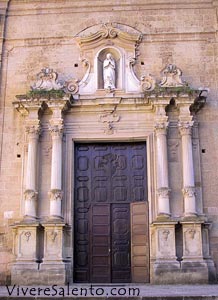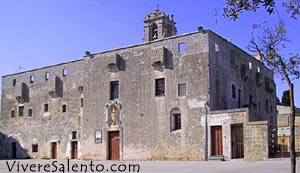|
|

The Castle of
Tricase is a stately building. It was built in 1661 by the Gallones. In Tricase
there were walls
 and
towers but there was not a real defensive building. Two towers of the 14th
century were included in the new building. The castle has been restored several
times. The portal was decorated in baroque style in contrast with the simple
style of the castle. The castle is now the Town Hall. The Mother Church was
built with the help of the population in the 18th century on the
rests of a pre-existing structure of the 16th century. It has a Latin
Cross shape and inside there are beautiful altars, paintings on sacred subjects
and a pulpit of 1795 by Raffaele Monteanni from Lequile. In this church there is
the Crypt of Our Lady of Pompei with the grave of the Cardinal Panico. Another
important church is the Church of St Domenico. It was built in the 17th
century in Baroque style. Its façade is decorated with sculptures and stuccos on
the stately portal there is a small statue of San Domenico from Guzman. The
wooden door was made by Oronzo Pirti and dates to the 17th century.
It is an aisleless church with ten altars decorated in a charming baroque style,
beautiful paintings (by Toma and by Catalano) and the fresco of St Liborio. The
high altar is richly decorated with rare marbles and our local stone. The Church
of the Devils is outside the urban area and dates to the 17th
century. It has an octagonal shape. The Church of St Michael Archangel dates to
the 17th century, has a Renaissance style and was built according to
the will of Cesare Gallone. In Tricase the tourist can visit also several
chapels: the Chapel of Our Lady of the Carmine dates to 1934, is very simple and
has only one altar. The Chapel of the Virgin was built in 1850 and has some
interesting frescos inside. The Chapel Oasis and the and
towers but there was not a real defensive building. Two towers of the 14th
century were included in the new building. The castle has been restored several
times. The portal was decorated in baroque style in contrast with the simple
style of the castle. The castle is now the Town Hall. The Mother Church was
built with the help of the population in the 18th century on the
rests of a pre-existing structure of the 16th century. It has a Latin
Cross shape and inside there are beautiful altars, paintings on sacred subjects
and a pulpit of 1795 by Raffaele Monteanni from Lequile. In this church there is
the Crypt of Our Lady of Pompei with the grave of the Cardinal Panico. Another
important church is the Church of St Domenico. It was built in the 17th
century in Baroque style. Its façade is decorated with sculptures and stuccos on
the stately portal there is a small statue of San Domenico from Guzman. The
wooden door was made by Oronzo Pirti and dates to the 17th century.
It is an aisleless church with ten altars decorated in a charming baroque style,
beautiful paintings (by Toma and by Catalano) and the fresco of St Liborio. The
high altar is richly decorated with rare marbles and our local stone. The Church
of the Devils is outside the urban area and dates to the 17th
century. It has an octagonal shape. The Church of St Michael Archangel dates to
the 17th century, has a Renaissance style and was built according to
the will of Cesare Gallone. In Tricase the tourist can visit also several
chapels: the Chapel of Our Lady of the Carmine dates to 1934, is very simple and
has only one altar. The Chapel of the Virgin was built in 1850 and has some
interesting frescos inside. The Chapel Oasis and the Chapel of Our Lady of Intercession were built in 1961 and in 1978. The Chapel of
Our Lady of Help is small and was restored in 1984. A painting of the Virgin
with the Child can be admired on its altar. The Chapel of Our Lady of the Pity
and the Chapel of St Anna are both aisleless churches with a single altar. The
Chapel of St Rocco dates to 1965. On the sea-cost (Tricase Porto) there are: the
Chapel of the SS Medici (1967), the Chapel of St Elia (17th century),
and the Chapel of Our Lady of Lourdes (1873). The Byzantine Crypt of Our Lady of
Gonfalone was dug in the rocks in the 9th century probably by the
Basilian Monks during the religious persecutions. Inside there were some frescos
but they were never restored and are in a state of neglect. In Tricase there
were three dovecots where people used to grow doves because the meat of those
birds was considered as rare and tasty especially by the clergy and the wealthy
classes. Those are the names of the dovecots of Tricase: the Torre del Mito
(7,70 m high) dates to the 17th century, the Torre Palummaru was
destroyed in 1992, the Torre Melacca is the oldest because it dates to 1555 and
is 6.65 m high. Tricase is an important village to visit also for the huge and
stately ‘Quercia Vallonea’ a majestic oak-tree from the 12th
century. The patron saint of Tricase is St Vito Martyr and the population
celebrates him on August 7th, 8th and 9th.
Chapel of Our Lady of Intercession were built in 1961 and in 1978. The Chapel of
Our Lady of Help is small and was restored in 1984. A painting of the Virgin
with the Child can be admired on its altar. The Chapel of Our Lady of the Pity
and the Chapel of St Anna are both aisleless churches with a single altar. The
Chapel of St Rocco dates to 1965. On the sea-cost (Tricase Porto) there are: the
Chapel of the SS Medici (1967), the Chapel of St Elia (17th century),
and the Chapel of Our Lady of Lourdes (1873). The Byzantine Crypt of Our Lady of
Gonfalone was dug in the rocks in the 9th century probably by the
Basilian Monks during the religious persecutions. Inside there were some frescos
but they were never restored and are in a state of neglect. In Tricase there
were three dovecots where people used to grow doves because the meat of those
birds was considered as rare and tasty especially by the clergy and the wealthy
classes. Those are the names of the dovecots of Tricase: the Torre del Mito
(7,70 m high) dates to the 17th century, the Torre Palummaru was
destroyed in 1992, the Torre Melacca is the oldest because it dates to 1555 and
is 6.65 m high. Tricase is an important village to visit also for the huge and
stately ‘Quercia Vallonea’ a majestic oak-tree from the 12th
century. The patron saint of Tricase is St Vito Martyr and the population
celebrates him on August 7th, 8th and 9th.

In the past
the nickname of Tricase was "pelacane" from the Greek term "pelacao", that means
"skin tanners". Between the 15th and the 17th century the
people of Tricase became very good tanners thank to a substance they extracted
from their oak-tree. They used to sell their skins in the harbour and when the
harbour was closed by the Viceroy d’Ognatte (1649) in order to prevent
smuggling, this was a disaster for the economy of the village. The people of
Tricase became good farmers and specialized in the growing of pumpkins and the
second nickname of those people is ‘cucuzzari’ which means ‘pumpkin grower’
|